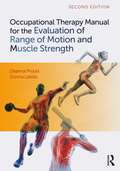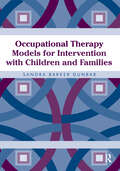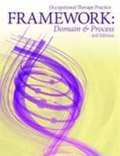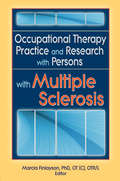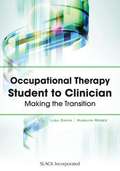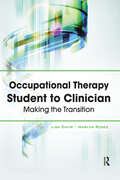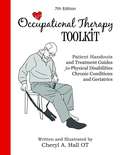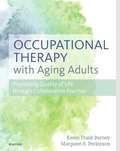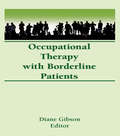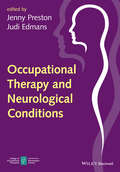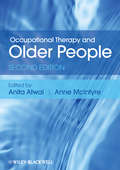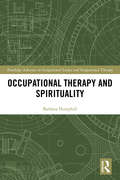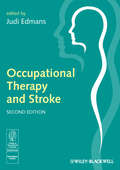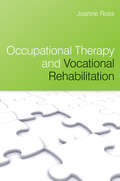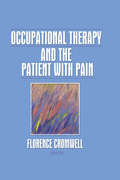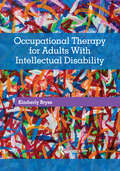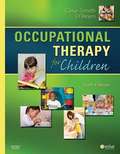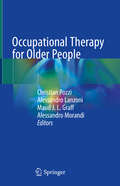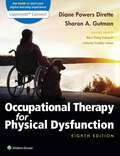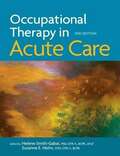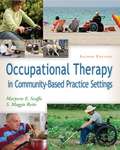- Table View
- List View
Occupational Therapy Manual for the Evaluation of Range of Motion and Muscle Strength
by Donna Latella Deanna ProulxAimed at occupational therapy practitioners, this practical and comprehensive manual demonstrates how different assessment tools can be used to evaluate the range of motion, and strength of clients, during physical rehabilitation.The book covers the key areas of evaluation that therapists need to understand, including activity analysis, clinical observation, active range of motion, gross motor testing, goniometry, and isolated muscle testing. Reconfigured to match the clinical reasoning process, this new edition has also been reorganized by region and by joint motion to make it more user-friendly, mirroring the process by which an evaluation is conducted in practice. Also included are various appendices to support the transition to practice, as well as an "At a Glance" version of the manual itself.This is an essential manual for both occupational therapy practitioners and students in training.
Occupational Therapy Models for Intervention with Children and Families
by Sandra DunbarOccupational Therapy Models for Intervention with Children and Families explores recent theoretical models that enable occupational therapists to practice and interact with families in a more holistic and occupation-centered manner. This comprehensive and dynamic text offers the latest information on viewing the broader contexts of environment and family in order to meet diverse occupational needs in a range of settings.Sandra Barker Dunbar presents a variety of case scenarios that feature culturally diverse populations and varying diagnoses of children with occupational needs. With contributions from 11 renowned leaders in occupational therapy, this comprehensive text is designed to increase awareness and understanding of theoretical models and their relationship to current occupational therapy practice with today’s children and families.Inside Occupational Therapy Models for Intervention with Children and Families, traditional frames of reference in pediatric practice are explored, including sensory integration and neurodevelopmental treatment. Some current theoretical models discussed include the Model of Human Occupation, the Person-Environment-Occupation model, the Ecology of Human Performance model, and the Occupational Adaptation model. The new Occupational Therapy Practice Framework is incorporated throughout the text.Employing a practical approach to this significant aspect of pediatric practice in occupational therapy, Occupational Therapy Models for Intervention with Children and Families is an invaluable tool for students at all curriculum levels.
Occupational Therapy Practice Framework: Domain and Process
by American Occupational Therapy Association StaffAs occupational therapy celebrates its centennial in 2017, attention returns to the profession's founding belief in the value of therapeutic occupations as a way to remediate illness and maintain health. The founders emphasized the importance of establishing a therapeutic relationship with each client and designing an intervention plan based on the knowledge about a client's context and environment, values, goals, and needs. Using today's lexicon, the profession's founders proposed a vision for the profession that was occupation based, client centered, and evidence based--the vision articulated in the third edition of the Occupational Therapy Practice Framework: Domain and Process. <P><P>The Framework is a must-have official document from the American Occupational Therapy Association. Intended for occupational therapy practitioners and students, other health care professionals, educators, researchers, payers, and consumers, the Framework summarizes the interrelated constructs that describe occupational therapy practice. In addition to the creation of a new preface to set the tone for the work, this new edition includes the following highlights: a redefinition of the overarching statement describing occupational therapy's domain; a new definition of clients that includes persons, groups, and populations; further delineation of the profession's relationship to organizations; inclusion of activity demands as part of the process; and even more up-to-date analysis and guidance for today's occupational therapy practitioners. <P><P>Achieving health, well-being, and participation in life through engagement in occupation is the overarching statement that describes the domain and process of occupational therapy in the fullest sense. The Framework can provide the structure and guidance that practitioners can use to meet this important goal.
Occupational Therapy Practice and Research with Persons with Multiple Sclerosis
by Marcia FinlaysonDiscover strategies to enhance quality of life and promote social and community participation for people with MS! Occupational Therapy Practice and Research with Persons with Multiple Sclerosis will familiarize you with the complex issues experienced by people who have multiple sclerosis, suggesting ways to enhance your practice or research with this population. This vital resource fills a void in the scarce literature on occupational therapy and multiple sclerosis, providing you with a unique single-source reference on the subject. This book compiles the work and contributions of experts from Europe, Australia, Canada, and the United States-from a variety of fields, including occupational therapy, medicine, physical therapy, and psychology. This thought-provoking book offers new perspectives on potential assessment and intervention ideas and provides information that could be used for broader program planning. This extensive resource will give you a deeper appreciation of the MS disease process and its influence on everyday living for persons with MS and their families. In this collection, you will learn more about: the health-related service needs of older adults with MS the range of fatigue assessment tools that are available for clinical and research applications the effect of wheelchair use on quality of life the implications of tremor on everyday activities the development and use of Lifestyle Management Programs© coping processes used by women with MS as they age the symptom and functional limitation profiles experienced by people with MS that lead to referrals to occupational therapy Occupational Therapy Practice and Research with Persons with Multiple Sclerosis contains charts, figures, graphs, and bibliographies to augment the research and studies found in this book. Also provided are contributions by Dr. Nicholas G. LaRocca-a well-known MS researcher-and Dr. Carol A. Gaetjens-an educator with MS. Occupational therapy students, clinicians, and researchers working with individuals and families who are affected by MS will find this book an important resource in their profession.
Occupational Therapy Protocol Management in Adult Physical Dysfunction (Aspen Series in Occupational Therapy Ser.)
by Marilyn S. Daniel Randy StricklandThis outstanding resource presents treatment considerations and techni ques defined by therapists at the University of Texas Medical Branch. Filled with treatment information on 27 varying diagnoses, each chapte r includes a medical summary, an occupational therapy protocol (object ives, evaluation tools, treatment considerations and techniques, disch arge and follow-up), evaluation forms, and procedures specific to each diagnosis. Also included are sections in goal writing for documentati on and reimbursement, with sample goals for every treatment recommende d in each of the protocols. The looseleaf format allows for easy use o f the protocols and evaluations--ready to copy or revise to meet the n eeds of any adult physical health occupational therapy program.
Occupational Therapy Student to Clinician: Making the Transition
by Lisa Davis Marilyn RoseeIt is an imperative need and a great challenge to support the professional development of competent OTs. The complexity of demands in the workforce exceeds the requisite of clinical knowledge and reasoning.
Occupational Therapy Student to Clinician: Making the Transition
by Lisa Davis Marilyn RoseeIt is surprising that there is no “go-to” resource for the occupational therapy or occupational therapy assistant student to have when they embark on their professional journey. With this in mind, Lisa Davis and Marilyn Rosee have written Occupational Therapy Student to Clinician: Making the Transitionto help students hone the skills employers look for in new hires. While many academic programs cover career-oriented topics, this is the first specific text to pull the pieces together with the purpose of showing readers how to become successful job candidates and employees. Perfect for the student preparing for an occupational therapy career, Occupational Therapy Student to Clinician covers all pragmatic issues that students face while securing their first job. This text outlines a variety of topics including résumé writing, interview skills, negotiating a salary, working within a team, developing professional competencies, and understanding the culture of an organization. Each chapter includes learning objectives and lists of practice activities that students can use to reinforce their skills.Occupational Therapy Student to Clinician: Making the Transition will benefit occupational therapy and occupational therapy assistant students preparing to graduate, as well as employed clinicians dealing with specific employment-related issues. This text will also guide the employee who wants to move to the next job and reacquaint themselves with the job-seeking process. This comprehensive resource provides strategies and solutions for many employment challenges and will be an asset in any professional development curriculum.
Occupational Therapy Toolkit: Treatment Guides And Patient Education Handouts
by Cheryl A. HallFully revised and expanded in 2018. The Occupational Therapy Toolkit 7th edition is a collection of 354 full-page illustrated patient handouts. The handouts are organized by 97 treatment guides and are based on current research and best practice. This 787 page practical resource is the BEST resource for every therapist working with physical disabilities, chronic conditions or geriatrics.
Occupational Therapy With Aging Adults: Promoting Quality Of Life Through Collaborative Practice
by Karen Barney Margaret PerkinsonLook no further for the book that provides the information essential for successful practice in the rapidly growing field of gerontological occupational therapy! Occupational Therapy with Aging Adults is a new, comprehensive text edited by OT and gerontological experts Karen Frank Barney and Margaret Perkinson that takes a unique interdisciplinary and collaborative approach in covering every major aspects of geriatric gerontological occupational therapy practice. With 30 chapters written by 70 eminent leaders in gerontology and OT, this book covers the entire continuum of care for the aging population along with special considerations for this rapidly growing demographic. This innovative text also covers topical issues spanning the areas of ethical approaches to treatment; nutrition and oral health concerns; pharmacological issues; low vision interventions; assistive technology supports; and more to ensure readers are well versed in every aspect of this key practice area.
Occupational Therapy With Borderline Patients
by Diane GibsonThis volume discusses and reviews the current knowledge in the concept and management of activity groups designed for borderline patients, who are defines as those with “self-destructive and maladaptive interpersonal relations.”
Occupational Therapy and Neurological Conditions
by Judi Edmans Jenny PrestonAn introductory, comprehensive textbook covering all aspects of the occupational needs of clients with neurological conditions. Written from an occupational perspective and for the needs of occupational therapists and their clients Ideal for students and newly qualified practitioners to provide them with an overview of this key area of practice Includes case studies to place material within the context of practice Officially endorsed by the College of Occupational Therapists
Occupational Therapy and Older People
by Anita Atwal Anne McintyreThis book locates older people as major clients of occupational therapy services. It provides a comprehensive resource for students and a basic working reference for clinicians. The book encompasses current theories, debates and challenges which occupational therapists need to engage in if they are to provide pro-active and promotional approaches to ageing. Detailed coverage of bodily structures, functions and pathologies leads onto chapters dedicated to activity, occupation and participation. The ethos of the book is to inspire innovation in the practice of occupational therapy with older people, promoting successful ageing that entails control and empowerment. This new edition has been fully revised and updated. In addition brand new material has been included on occupational transitions (retirement, frailty and end of life); user perspectives; public health including advocacy, enablement and empowerment; people entering old age with disability and mental health conditions; visual impairment; assistive technology driving and ageism.
Occupational Therapy and Older People (Coursesmart Ser.)
by Anita Atwal Anne McIntyreThis timely book locates older people as major clients of occupational therapy services. It provides a comprehensive resource for students and a basic working reference for clinicians. The book encompasses current theories, debates and challenges which occupational therapists need to engage in if they are to provide pro-active and promotional approaches to ageing. Detailed coverage of bodily structures, functions and pathologies leads onto chapters dedicated to activity, occupation and participation. The ethos of the book is to inspire innovation in the practice of occupational therapy with older people, promoting successful ageing that entails control and empowerment. Features: Contains many practical elements, including case studies, and narratives from practice. Promotes active ageing. Adopts the framework of the World Health Organisation’s International Classification of Functioning, Disability and Health (2001) Specialist contributions reveal the diversity of occupational performance considerations in older age.
Occupational Therapy and Spirituality (Routledge Advances in Occupational Science and Occupational Therapy)
by Barbara HemphillSpirituality is an important aspect of occupational therapy theory and practice, yet it remains little understood. This timely book adds to the current debate by exploring the meaning of spirituality within occupational therapy and by outlining evidence which supports this area of practice. Beginning with the three stances surrounding spirituality for the common good and the theology of occupation, throughout its 10 chapters the book goes on to cover topics such as: Spirituality of caring; Theories of spiritual development; Definition of spirituality from occupational therapy literature; Differences between assessing spirituality and religion; Spirituality and ethics; Spiritual and cultural diversity in the occupational therapy clinic; Therapeutic self. By the end of the volume the reader will have the toolset required to consider spiritual concepts and their application to health principles. Occupational Therapy and Spirituality is written in an accessible format and is designed for occupational therapy and occupational science academics, researchers, and graduate students.
Occupational Therapy and Stroke
by Judi EdmansOccupational Therapy and Stroke guides newly qualified occupational therapists (and those new to the field of stroke management) through the complexities of treating people following stroke. It encourages and assists therapists to use their skills in problem solving, building on techniques taught and observed as an undergraduate.Written and edited by practising occupational therapists, the book acknowledges the variety of techniques that may be used in stroke management and the scope of the occupational therapist's role. Chapters span such key topics as early intervention and the theoretical underpinnings of stroke care, as well as the management of motor, sensory, cognitive and perceptual deficits. They are written in a user-friendly style and presented in a form that enables the therapist to review the subject prior to assessment and treatment planning. Complex problems are grouped together for greater clarity.This second edition has been fully revised and updated in line with the WHO ICF model, National Clinical Guidelines and Occupational Therapy standards. It is produced on behalf of the College of Occupational Therapists Specialist Section - Neurological Practice.
Occupational Therapy and Vocational Rehabilitation
by Joanne RossThis book introduces the occupational therapist to the practice of vocational rehabilitation. As rehabilitation specialists, Occupational Therapists work in a range of diverse settings with clients who have a variety of physical, emotional and psychological conditions. Research has proven that there are many positive benefits from working to health and well-being. This book highlights the contribution, which can be made by occupational therapists in assisting disabled, ill or injured workers to access, remain in and return to work.
Occupational Therapy and Women’s Health: A Practitioner Guide
by Sabina KhanThis innovative and comprehensive textbook provides a detailed exploration of the role of occupational therapy in addressing the unique needs of women across the lifespan.Structured into 14 parts, the book begins with the foundations of women’s health, delving into its historical evolution, the significance of gender equality in medical research, the implications of employment on women's well-being, intricate sociocultural influences, and the intersection of women and occupation from an occupational therapy perspective. Following this foundational context, the book journeys through diverse areas such as gynecological and obstetric health management, endocrine health, autoimmune conditions, non-cisgender health in the context of women’s health, mental health and biopsychosocial aspects, cardiovascular health, sleep, weight, and lifestyle factors, oncology, neurological health, women's health across the lifespan, inter-partner violence and trauma-informed care, and special topics in women's health.Women’s health is a universal concern that transcends geographical boundaries, cultural differences, and socioeconomic disparities, and this important book will be key reading for both students and practitioners of occupational therapy.
Occupational Therapy and the Patient With Pain
by Florence S CromwellThis volume speaks to the issue of occupational therapy practice with the patient in pain. The hows and whys of treatment are explored in a broad range of chapters written by and for professionals in the field of occupational therapy.
Occupational Therapy for Adults With Intellectual Disability
by Kimberly BryzeOccupational Therapy for Adults With Intellectual Disability provides occupational therapy practitioners and students with occupation-based solutions to serve and empower individuals with intellectual disabilities, as well as their families and caregivers, towards more self-determined, authentic lives.There are few texts that exist within occupational therapy that support this population. Dr. Kimberly Bryze and the contributing authors are all occupational therapists who have or currently provide occupational therapy services to adults with intellectual disability in various settings. They bring their expertise in scholarship and offer thoughtful, evidence-based approaches for practitioners to create change for individuals, communities, organizations, and society.This text presents an occupational perspective of individuals with intellectual disability given its focus on the following: quality of living social well-being role competence occupational identity self-advocacy occupational justice Occupational Therapy for Adults with Intellectual Disability is ideal for occupational therapy educators who teach content related to adults with intellectual and developmental disabilities, occupational therapy practitioners who provide services to adults with intellectual disability in various clinical, community, and residential settings, and occupational therapy students. Included with the text are online supplemental materials for faculty use in the classroom.The intentional, occupational focus ensures that the content is consistent with recommended practice in current occupational therapy. Occupational therapy practitioners will look to this text to provide evidence-based interventions and when developing consultative programs for persons with intellectual disability across many different settings.
Occupational Therapy for Children - Elsevier on VitalSource
by Jane Clifford O'Brien Jane Case-SmithUnique Evolve Resources website reinforces textbook content with video clips and learning activities for more comprehensive learning. Case studies help you apply concepts to actual situations you may encounter in practice. Evidence-based practice focus reflects the most recent trends and practices in occupational therapy. Unique! Chapter on working with adolescents helps you manage the special needs of this important age group. Unique! Research Notes boxes help you interpret evidence and strengthen your clinical decision-making skills. Video clips on a companion Evolve Resources website reinforce important concepts and rehabilitation techniques.
Occupational Therapy for Older People
by Christian Pozzi Alessandro Lanzoni Maud J. L. Graff Alessandro MorandiThis book focuses on evidence-based occupational therapy in the care of older adults in different clinical settings, from home to acute hospital, from intensive care unit to rehabilitation centers and nursing homes. Occupational therapy has progressively developed as a new discipline aiming to improve the daily life of individuals of different ages, from children to older adults. The book first reviews the interaction between occupational therapy and geriatrics and then discusses in depth how occupational therapy interventions are applied in the community, in the acute hospital and in the nursing home. It highlights the key role of occupational therapy in the management of frail patients, including critically ill older patients and persons with dementia, and describes in detail how to maintain occupational therapy interventions across different settings to avoid the fragmentation of care. The ageing population requires new innovative approaches to improve the quality of life, and as such this book provides clinicians with handy, key information on how to implement occupational therapy in the daily clinical care of older adults based on the current scientific evidence.
Occupational Therapy for Physical Dysfunction
by Sharon A. Gutman Diane DiretteDesigned to help students become effective, reflective practitioners, this fully updated edition of the most widely used occupational therapy text for the course continues to emphasize the “whys” as well as the “how-tos” of holistic assessment and treatment. Now in striking full color and co-edited by renowned educators and authors Diane Powers Dirette and Sharon Gutman, Occupational Therapy for Physical Dysfunction, Eighth Edition features expert coverage of the latest assessment techniques and most recent trends in clinical practice. In addition, the book now explicitly integrates “Frames of Reference” to help students connect theories to practice and features a new six-part organization, thirteen all-new chapters, new pedagogy, and more.
Occupational Therapy in Acute Care
by Helene Smith-Gabai Suzanne E. Holm"Occupational therapy is an allied health profession with an underlying belief that engaging in occupations promotes both health and wellness. While working in a hospital setting, which operates predominantly in a hierarchical and paternalistic medical model, occupational therapy professionals can find it difficult to reconcile the realities of this environment with their core professional values. <p><p>The challenge of acute care practice is looking beyond a specific medical condition and seeing the whole person. Working within a medical setting also requires an understanding of medical conditions and how illness affects occupational performance. What sets occupational therapy apart from other professions is an understanding of the totality of a patient's occupational profile and the importance of helping patients reclaim important roles and routines" <p>--Publisher's description
Occupational Therapy in Australia: Professional and Practice Issues
by Ted Brown Reinie Cordier Stephen Isbel Helen M. Bourke-Taylor Louise GustafssonThis ground-breaking text provides a comprehensive guide to the occupational therapy profession in Australia, from the profession’s role in the health care system to the broad scope and nature of its practice. The book is organised into three sections: the Australian context; professional issues and practice issues. Contributions from 80 Australian occupational therapists working in education, research, policy and practice bring together the most relevant and up-to-date information in this essential book. The authors begin the Australian environment section with an overview of the Australian health care system, a history of occupational therapy in Australia and the role of Australian occupational therapy professional associations and regulatory bodies. The values and philosophy of occupational therapy, ethical and legal aspects of practice and the role of occupational therapy in population health and health promotion are considered next. The professional issues covered in the book include using effective communication skills, client-centred practice principles and a strength-based approach when working with individuals, families, groups, communities, organisations and populations. Additional topics, including occupational science, the education of occupational therapists, research in occupational therapy, evidence-based practice clinical reasoning and occupational therapy models of practice, are also covered in the middle section of the book. Occupational Therapy in Australia: Practice and Process Issues is established as the essential practice reference for students, practitioners and educators in Australia. This second edition has been revised and updated throughout and includes new chapters on communication skills, environmental aspects of occupational therapy practice and decolonising occupational therapy through a strength-based approach to practice.
Occupational Therapy in Community-Based Practice Settings (2nd Edition)
by Marjorie E. Scaffa S. Maggie ReitzBe prepared for the growing opportunities to practice in community-based settings with the 2nd Edition of this groundbreaking resource. From basic principles and policy issues through the variety of settings to the future role of the OT, a noted authority in the field introduces you to all aspects of this rapidly expanding field of practice. You'll be prepared to take on new roles, to take unusual risks, and to envision service in creative ways. Reviews of the 1st Edition "This book is highly recommended not only to occupational therapy students and educators but to occupational therapy practitioners as well. For those employed in traditional hospital settings, the abundance of information may certainly help them expand their thinking about the scope of occupational therapy practice. " --Karen Butler Canadian Journal of Occupational Therapy "The text is easily readable and contains chapter key terms and learning objectives which help accentuate information. This text provides a much needed resource for occupational therapists who currently are, or plan to in the future, practice in the community. " --Peggy Wittman, EdD, OTR/L, FAOTA Occupational Therapy in Health Care Journal "Very comprehensive. Reviews a variety of possible settings for community practice and appears to cover the process from the beginning on through. " --Anne Marie Knecht, MA, OTR/L Florida International University, Miami, FL
